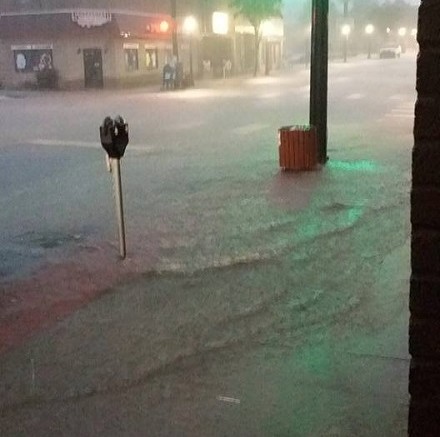[Statements, opinion, and views expressed in this column are those of the author named and are not necessarily those of the EllwoodCity.org and Thought Process Enterprises team.]
Tuesday, I got to work after being sick for a day and spending the storm sleeping and eating soup. I checked our twitter feed and found this gem: “Residents trapped in collapsed structure undermined due to flooding on River Rd, Ellwood City.”
Was it a breaking story that I missed and needed to rush to complete? Then, I noticed something odd about it.
It included a picture of the intersection of Lawrence and Sixth Street, taken from right by EllwoodCity.org’s prestigious headquarters and showing Sportswear Graphics. The streets were indeed flooded but as far as I could see, our local sports store remained intact.
Somehow, after this picture was posted by the photographer, it got tagged in this tweet. The information was fabricated, an incorrect picture associated with it, and I don’t know how River Road got thrown in.
The tweet was credited to the National Weather Service and actual news sources tweeted it. I counted 28 posts with some variants:
“A lot going on w the weather tonight. NWS reports people trapped by flood waters in Ellwood City–collapsed structure.”
“Local media reports residents trapped in collapsed structure amid flooding in Ellwood City, Pa.”
My personal favorite is one that includes the end line “climate change is real,” because storms never collapsed buildings before climate change.
After imagining Ellwoodians huddled in the sporting apparel store lighting candles and checking for zombies in the storm, I remembered the actual lesson here: the Internet is a haven for fabricated information.
Anyone, including news anchors, can fall prey to a tweet chain of wrong information. It’s important to always track the information to the source to confirm its accuracy, not just for journalists, but for everyone.
At least 28 people shared this tweet without noticing the so-called undermined structure was completely intact. Nobody checked local media to see if they initially reported the accident.
There are other cases where it’s far more difficult to track information, but if it involves something that alters your perception on the world, such as climate change, take the time to do the research. Even when journalists are doing their best, they make mistakes.


Be the first to comment on "That Time People Got Trapped in an Undermined Building"